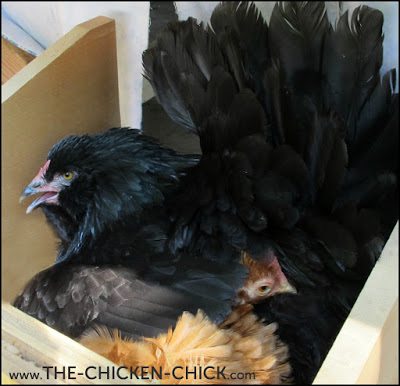I received a sad and shocking message from a chickeneering friend this week; when he went to collect eggs mid afternoon, his favorite Silkie hen was in a nest box, deceased. Temperatures have been in the single digits and she hadn’t been there more than a few hours. Her passing was not in vain, however, as we can learn some important lessons for our own flocks from her untimely end.


WHAT IS A BROODY HEN?
We refer to a hen as “broody” when motherhood beckons and she answers the call to find a nest to hatch chicks. Broodiness is influenced by many factors, including genetics, lighting conditions, and hormones, and while most common in spring, it can occur any time of year, including the coldest days of winter. Some breeds tend towards broodiness often, some, never. Silkies, Orpingtons, Cochins, and Australorps are all considered broody breeds.


Broody hens instinctively seek secluded, dark locations to hide their eggs from predators, they will sit on eggs they laid, on eggs that other birds laid, and even on empty nests. A broody hen’s behavior is easy to identify: when disturbed, she growls, shrieks, puffs out her feathers, and may peck the intruder in defense of her eggs; she plucks feathers from her belly to expose the warmth and moisture of her skin directly to the eggs, and she sits stoically in the nest all day, leaving briefly at most once or twice a day to eat, drink, dust bathe, and relieve herself. The drastic change in a broody’s daily routine takes a significant toll on her health. Because she drinks less, poops much less frequently, and eats 80 percent less food than normal, she loses a considerable amount of weight, her circulation is decreased, her comb turns pale, and she will lose feathers from malnutrition. Broody behavior is unhealthy any time of the year, and in frigid temperatures when chickens must increase their feed and water intake to maintain body temperatures, broodiness is life-threatening.






In extremely cold temperatures, broody behavior should be discouraged immediately by “breaking up” the hen. There are many suggested methods for broody breaking, some unreliable or ineffective, some cruel and inhumane. I strongly recommend against any technique involving water or ice. I also do not recommend the “boomerang” method of taking a hen out of the nest repeatedly, only to have her panic and run back to her nest. This method is unreliable and unnecessarily stressful for everyone. The method I recommend for breaking up a broody hen in cold temperatures is known as the “broody breaker.” The broody breaker is the most efficient and reliable method for discouraging broodiness. The concept is simple: place the hen in a wire-bottomed cage raised off the floor in a safe, warm, well-lit location away from the coop. For complete details for breaking up a broody hen, please read this article.


BROODY HEN BEST PRACTICES IN EXTREME COLD
- Monitor nest boxes for broody behavior whenever visiting the coop, particularly during nightly lockup.
- Hens identified as broody that will not be hatching eggs must be broken up immediately.
- Hens identified as broody that will be hatching eggs must be moved out of the coop to a safe, warm location.
- If a hen occupies a nest box for more than an hour, assume she is broody and break her up.
- Never allow a broody hen to sit on eggs for the purpose of keeping table eggs warm in extremely cold temperatures. If the nest box is cold enough to freeze eggs, it’s cold enough to cause hypothermia and death.
- If nest boxes are drafty or external to the coop, insulate them. If hens begin picking the insulation, cover it with empty feed bags.
Kathy Shea Mormino
Affectionately known internationally as The Chicken Chick®, Kathy Shea Mormino shares a fun-loving, informative style to raising backyard chickens. …Read on




shop my SPONSORS
I received a sad and shocking message from a chickeneering friend this week; when he went to collect eggs mid afternoon, his favorite Silkie hen was in a nest box, deceased. Temperatures have been in the single digits and she hadn’t been there more than a few hours. Her passing was not in vain, however, as we can learn some important lessons for our own flocks from her untimely end.


WHAT IS A BROODY HEN?
We refer to a hen as “broody” when motherhood beckons and she answers the call to find a nest to hatch chicks. Broodiness is influenced by many factors, including genetics, lighting conditions, and hormones, and while most common in spring, it can occur any time of year, including the coldest days of winter. Some breeds tend towards broodiness often, some, never. Silkies, Orpingtons, Cochins, and Australorps are all considered broody breeds.


Broody hens instinctively seek secluded, dark locations to hide their eggs from predators, they will sit on eggs they laid, on eggs that other birds laid, and even on empty nests. A broody hen’s behavior is easy to identify: when disturbed, she growls, shrieks, puffs out her feathers, and may peck the intruder in defense of her eggs; she plucks feathers from her belly to expose the warmth and moisture of her skin directly to the eggs, and she sits stoically in the nest all day, leaving briefly at most once or twice a day to eat, drink, dust bathe, and relieve herself. The drastic change in a broody’s daily routine takes a significant toll on her health. Because she drinks less, poops much less frequently, and eats 80 percent less food than normal, she loses a considerable amount of weight, her circulation is decreased, her comb turns pale, and she will lose feathers from malnutrition. Broody behavior is unhealthy any time of the year, and in frigid temperatures when chickens must increase their feed and water intake to maintain body temperatures, broodiness is life-threatening.






In extremely cold temperatures, broody behavior should be discouraged immediately by “breaking up” the hen. There are many suggested methods for broody breaking, some unreliable or ineffective, some cruel and inhumane. I strongly recommend against any technique involving water or ice. I also do not recommend the “boomerang” method of taking a hen out of the nest repeatedly, only to have her panic and run back to her nest. This method is unreliable and unnecessarily stressful for everyone. The method I recommend for breaking up a broody hen in cold temperatures is known as the “broody breaker.” The broody breaker is the most efficient and reliable method for discouraging broodiness. The concept is simple: place the hen in a wire-bottomed cage raised off the floor in a safe, warm, well-lit location away from the coop. For complete details for breaking up a broody hen, please read this article.


BROODY HEN BEST PRACTICES IN EXTREME COLD
- Monitor nest boxes for broody behavior whenever visiting the coop, particularly during nightly lockup.
- Hens identified as broody that will not be hatching eggs must be broken up immediately.
- Hens identified as broody that will be hatching eggs must be moved out of the coop to a safe, warm location.
- If a hen occupies a nest box for more than an hour, assume she is broody and break her up.
- Never allow a broody hen to sit on eggs for the purpose of keeping table eggs warm in extremely cold temperatures. If the nest box is cold enough to freeze eggs, it’s cold enough to cause hypothermia and death.
- If nest boxes are drafty or external to the coop, insulate them. If hens begin picking the insulation, cover it with empty feed bags.





























if you love your birds and take it seriously then take care of them, spoil them, keep them safe, altho there is the argument that they are basically wild creatures I don’t agree, like a dog or cat, they are dependent on your care, in the wild they may have more survival skills that they develop, but not once they are humanized, you need to take care of them like you would a dog or cat and I sure wouldn’t leave mine out in the freezing cold unless I was sure they had enuf natural items like hay, grass, pine… Read more »
The extra chores a broody hen needs certainly takes extra time.
I find it horrific that a chicken freezes to death while brooding, I live in Alaska where we have extreme weather and have NEVER lost a bird to freezing! EVER! Kripes, get a heat lamp they make them very safe nowadays. This just makes me angry because people who don’t know what they’re doing may be causing so much unnecessary suffering. I’ve had chickens for over 20 years and have never lost one to anything but a persistent bear that never came back after my lab/pit mix fought with it (medium sized black bear) and chased it back over the… Read more »
Great timely article! Thanks, Kathy!
Have one silly Silkie that always goes broody when the temps go frigid. Lucky enough to have broken her of it so far! Would love an incubator!